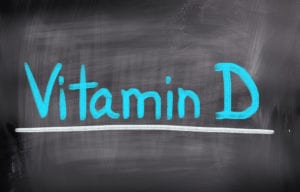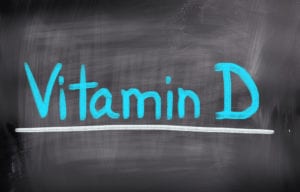Written by Chrystal Moulton, Science Writer. Women who were vitamin D adequate had significantly higher BMI-adjusted muscle mass index [SMIBMI] compared to those who were vitamin D inadequate (P = 0.039).
 Vitamin D deficiency is especially high among obese women of childbearing age (88%)1. Previous studies have demonstrated an association between vitamin D deficiency and obesity2. However, these studies do not consider other important variables related to distribution of body fat3. In addition, other studies have also shown that deficiency in vitamin D is associated with reduced muscle mass along with reduced muscular strength and function4. In the current study, investigators analyzed the association between circulating 25 (OH)D and variables related to body composition in adult women of childbearing age3.
Vitamin D deficiency is especially high among obese women of childbearing age (88%)1. Previous studies have demonstrated an association between vitamin D deficiency and obesity2. However, these studies do not consider other important variables related to distribution of body fat3. In addition, other studies have also shown that deficiency in vitamin D is associated with reduced muscle mass along with reduced muscular strength and function4. In the current study, investigators analyzed the association between circulating 25 (OH)D and variables related to body composition in adult women of childbearing age3.
This study was designed as a cross-sectional study of adult women of childbearing age. Women aged 20 to 49 years old who were overweight or obese according to BMI were included in this study. Participants were excluded if they were pregnant, nursing, menopausal, supplementing with vitamin D for the past 6 months, or underwent bariatric surgery. All participants were required to undergo nutritional, anthropometric, and biochemical evaluation. Serum concentrations of triglycerides, HDL cholesterol, and circulating concentrations of 25- hydroxy vitamin D [25 (OH) D] were measured. Thorough anthropometric evaluation including measurements of body fat and muscular mass distribution were also evaluated. Researchers used electric bioimpedance testing to determine muscular mass, fat free mass, fat mass, and percent body fat. Additional calculations were done using the results from the electric bioimpedance test to evaluate muscle mass against various indices. The women were divided into two groups based on circulating vitamin D status: adequate (25 [OH] D > 30ng/mL) and inadequate ( 25 [OH] D < 30ng/mL). Within the two groups researchers also divided the women based on BMI into 2 groups: normal versus overweight.
A total of 124 women with an average age of 34.07 ±7.13 years and BMI 24.20 ±3.48 kg/m2 were evaluated as part of this analysis. Average circulating concentration of 25 (OH) D was 28.83 ±10.35 ng/mL. 36.30% of participants were vitamin D adequate while 63.7% were inadequate. Researchers found that women who were vitamin D adequate had significantly higher BMI-adjusted muscle mass index [SMIBMI] compared to those who were vitamin D inadequate (P = 0.039). However, women who were vitamin D inadequate had significantly higher waist-to-height ratio and body adiposity index [BAI] values compared to those with adequate vitamin D (P = 0.021 and P = 0.019, respectively). Also, when considering body composition based on vitamin D serum concentrations, researchers found that women with normal body weight and inadequate vitamin D had significantly higher waist-to-height ratio compared to women with normal body weight an adequate vitamin D (P < 0.05). Furthermore, overweight women with vitamin D inadequacy had higher mean values of hip circumference, weight, and Belarmino-Waitzberg index compared to those who were overweight with adequate vitamin D (P < 0.05). Correlational analysis revealed a significant negative correlation between circulating vitamin D and fat-muscle ratio (R = -0.226, P = 0.026), fat mass index (R = -0.210, P = 0.039), percent body fat (R = -0.214, P = 0.035) conicity index (R = -0.207, P = 0.021), waist to height ratio (R = -0.218, P = 0.015), and waist circumference (R = -0.194, P = 0.031). However, a significant positive correlation was observed between circulating vitamin D and BMI adjusted muscle mass index [SMIBMI] (R = 0.219, P = 0.031). Further analysis of women with inadequate vitamin D showed a significant negative correlation between circulating vitamin D and visceral adiposity index (R = -0.359, P = 0.003). The correlation was significantly higher among women who were deficient in vitamin D (R = -0.520, P = 0.022).
Overall, this analysis demonstrated that vitamin D status was negatively correlated with body fat and positively correlated with muscle mass. Researchers determined that the indices which could be incorporated into clinical practice based on this analysis are BMI adjusted muscle mass index [SMIBMI] and waist-to-height ratio. Additional analysis will be needed to verify these findings.
Source: Magalhães, Paula Moreira, Sabrina Pereira da Cruz, Orion Araújo Carneiro, Michelle Teixeira Teixeira, and Andréa Ramalho. “Vitamin D Inadequacy and Its Relation to Body Fat and Muscle Mass in Adult Women of Childbearing Age.” Nutrients 16, no. 9 (2024): 1267.
© 2024 by the authors. Licensee MDPI, Basel, Switzerland. This article is an open access article distributed under the terms and conditions of the Creative Commons Attribution (CC BY) license (https://creativecommons.org/licenses/by/
4.0/).
Click here to read the full text study.
Posted June 4, 2024.
Chrystal Moulton BA, PMP, is a 2008 graduate of the University of Illinois at Chicago. She graduated with a bachelor’s in psychology with a focus on premedical studies and is a licensed project manager. She currently resides in Indianapolis, IN.
References:
- Karlsson T, Osmancevic A, Jansson N, Hulthén L, Holmäng A, Larsson I. Increased vitamin D-binding protein and decreased free 25(OH)D in obese women of reproductive age. Eur J Nutr. Feb 2014;53(1):259-67. doi:10.1007/s00394-013-0524-8
- Bennour I, Haroun N, Sicard F, Mounien L, Landrier JF. Vitamin D and Obesity/Adiposity-A Brief Overview of Recent Studies. Nutrients. May 13 2022;14(10)doi:10.3390/nu14102049
- Magalhães PM, Cruz SPD, Carneiro OA, Teixeira MT, Ramalho A. Vitamin D Inadequacy and Its Relation to Body Fat and Muscle Mass in Adult Women of Childbearing Age. Nutrients. Apr 25 2024;16(9)doi:10.3390/nu16091267
- Shoemaker ME, Salmon OF, Smith CM, Duarte-Gardea MO, Cramer JT. Influences of Vitamin D and Iron Status on Skeletal Muscle Health: A Narrative Review. Nutrients. Jun 29 2022;14(13)doi:10.3390/nu14132717







Comments (0)